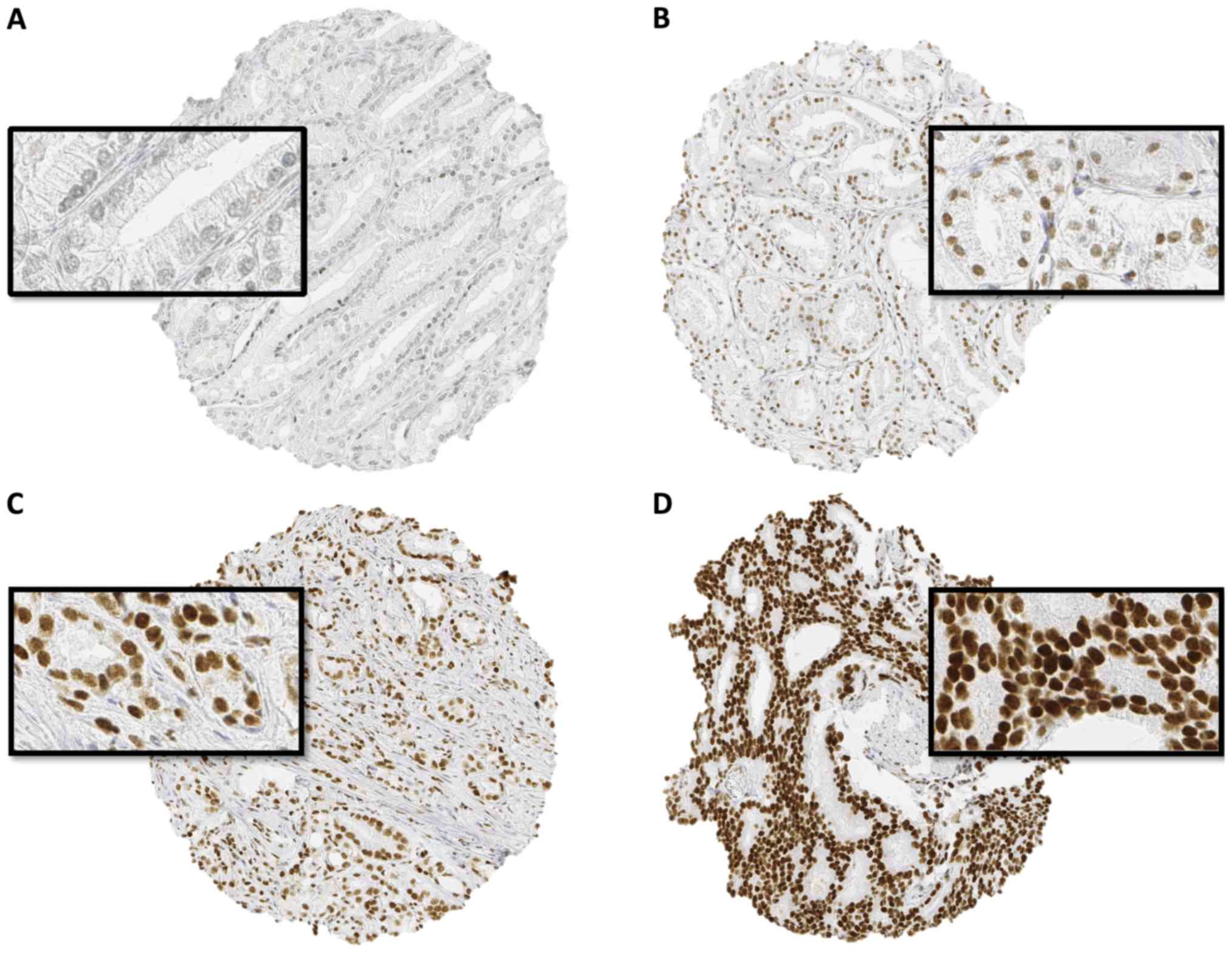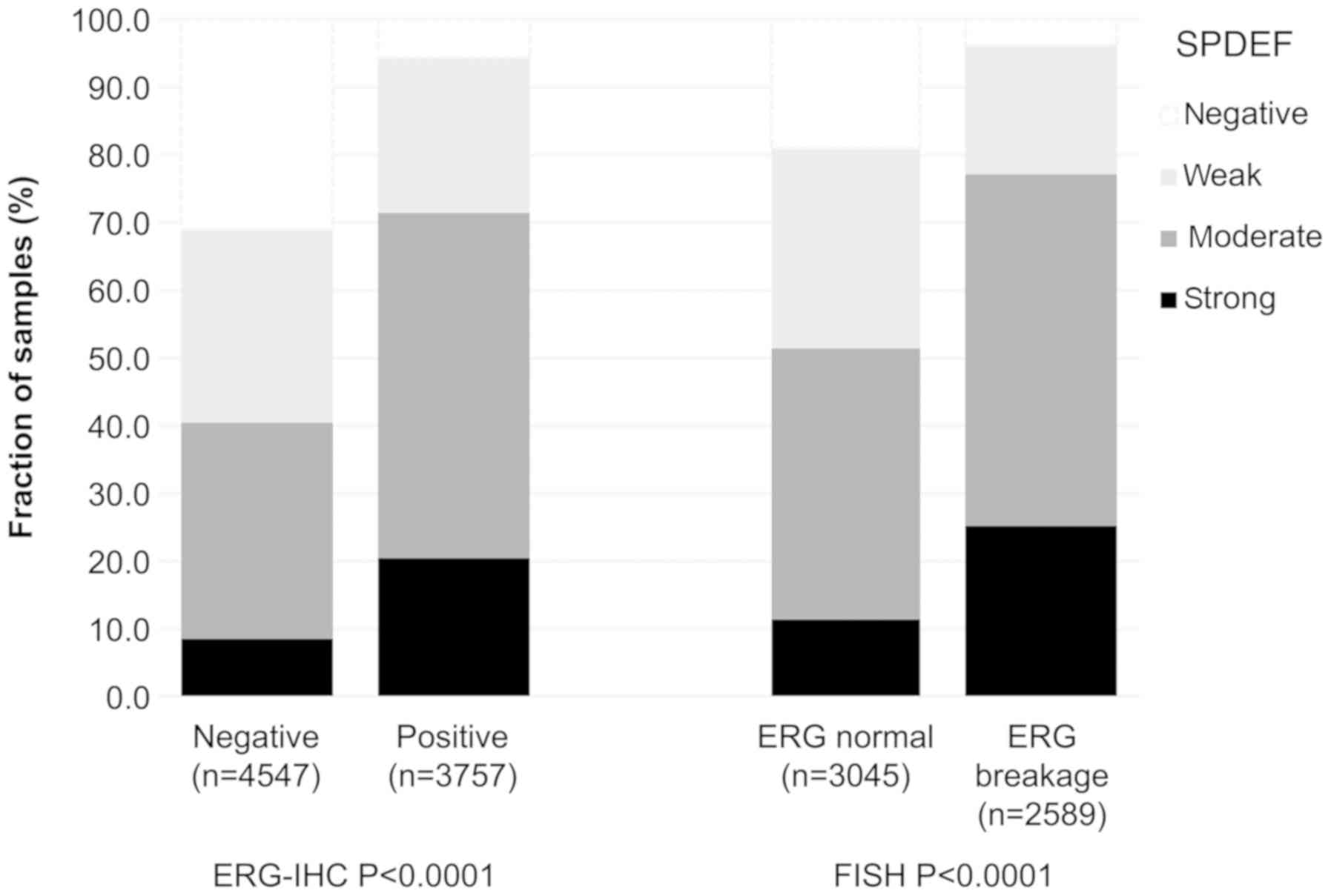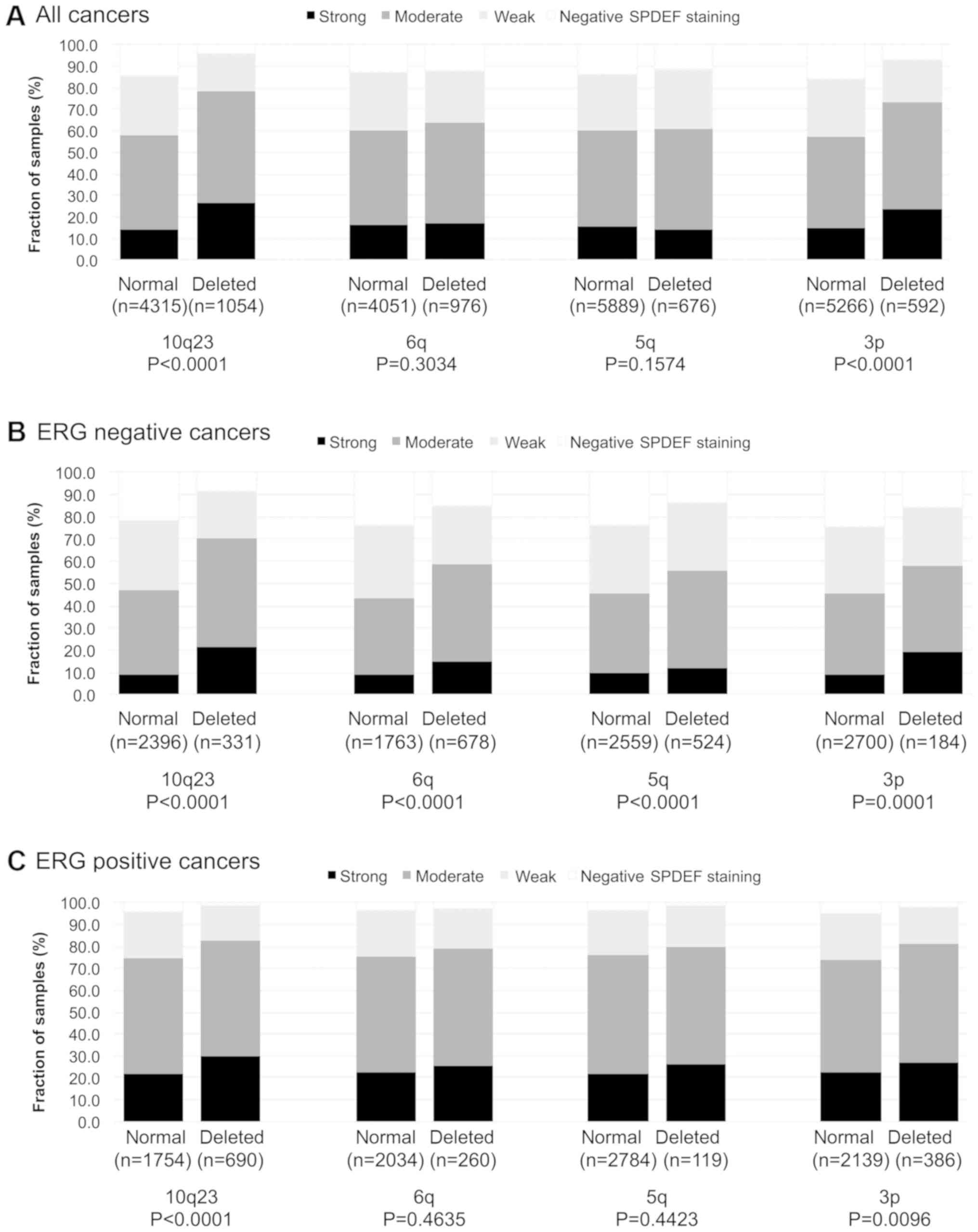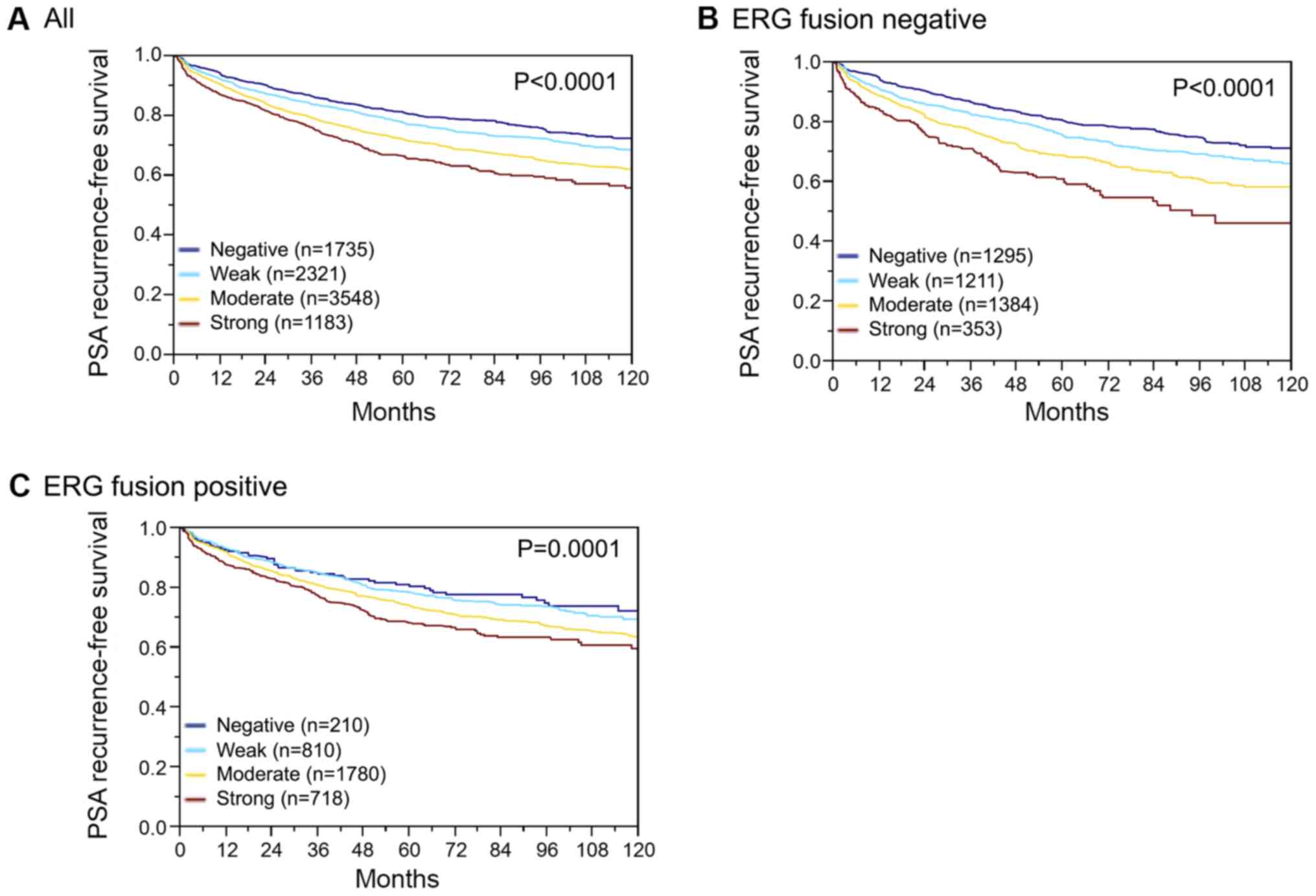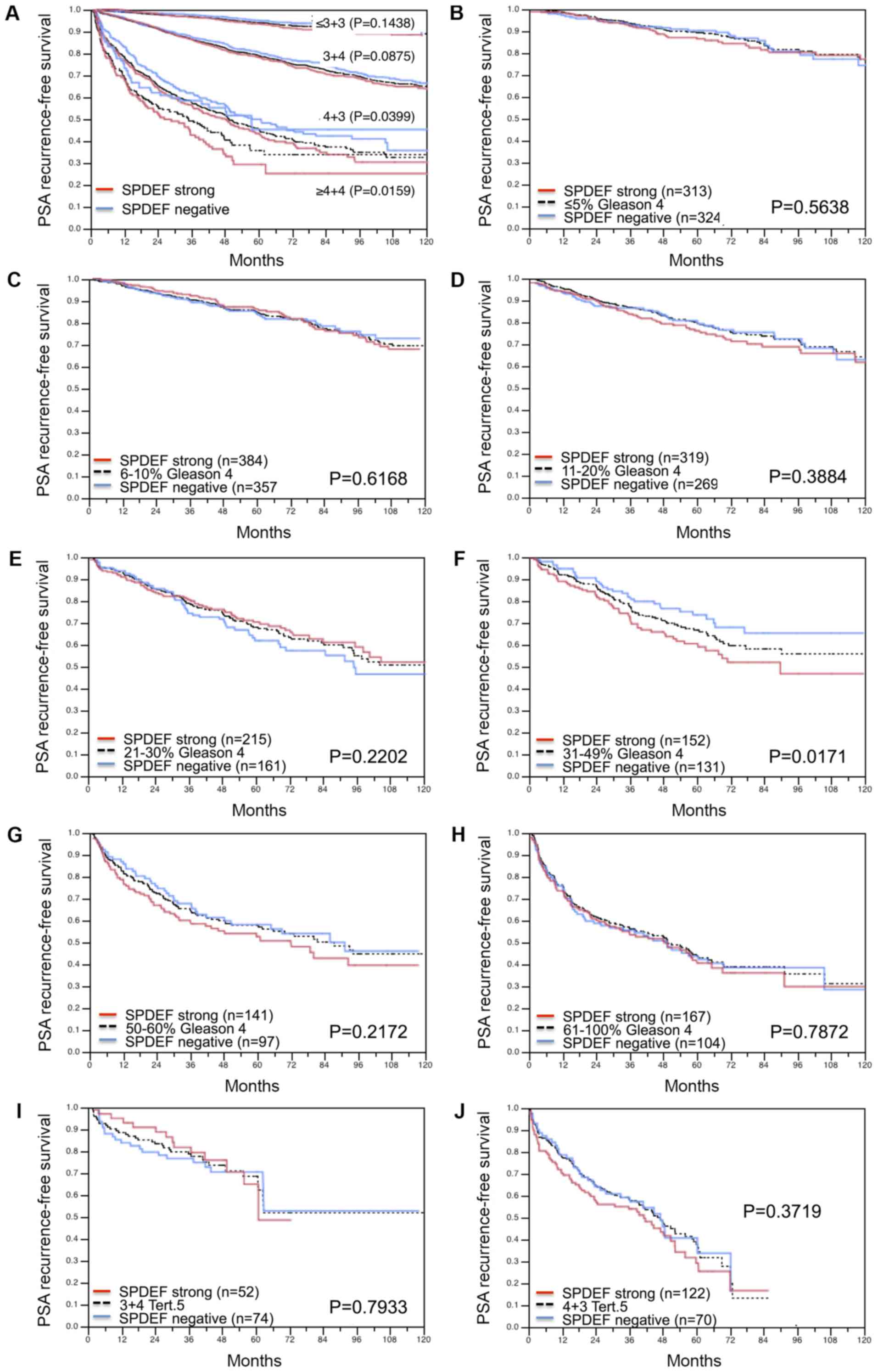|
1
|
Bray F, Ferlay J, Soerjomataram I, Siegel
RL, Torre LA and Jemal A: Global cancer statistics 2018: GLOBOCAN
estimates of incidence and mortality worldwide for 36 cancers in
185 countries. CA Cancer J Clin. 68:394–424. 2018. View Article : Google Scholar : PubMed/NCBI
|
|
2
|
Thompson IM Jr and Tangen CM: Prostate
cancer-uncertainty and a way forward. N Engl J Med. 367:270–271.
2012. View Article : Google Scholar : PubMed/NCBI
|
|
3
|
Wilt TJ, Brawer MK, Jones KM, Barry MJ,
Aronson WJ, Fox S, Gingrich JR, Wei JT, Gilhooly P, Grob BM, et al:
Radical prostatectomy versus observation for localized prostate
cancer. N Engl J Med. 367:203–213. 2012. View Article : Google Scholar : PubMed/NCBI
|
|
4
|
Sharrocks AD: The ETS-domain transcription
factor family. Nat Rev Mol Cell Biol. 2:827–837. 2001. View Article : Google Scholar : PubMed/NCBI
|
|
5
|
Clark JP and Cooper CS: ETS gene fusions
in prostate cancer. Nat Rev Urol. 6:429–439. 2009. View Article : Google Scholar : PubMed/NCBI
|
|
6
|
Kumar-Sinha C, Tomlins SA and Chinnaiyan
AM: Recurrent gene fusions in prostate cancer. Nat Rev Cancer.
8:497–511. 2008. View
Article : Google Scholar : PubMed/NCBI
|
|
7
|
Tomlins SA, Bjartell A, Chinnaiyan AM,
Jenster G, Nam RK, Rubin MA and Schalken JA: ETS gene fusions in
prostate cancer: From discovery to daily clinical practice. Eur
Urol. 56:275–286. 2009. View Article : Google Scholar : PubMed/NCBI
|
|
8
|
Oettgen P, Finger E, Sun Z, Akbarali Y,
Thamrongsak U, Boltax J, Grall F, Dube A, Weiss A, Brown L, et al:
PDEF, a novel prostate epithelium-specific ets transcription
factor, interacts with the androgen receptor and activates
prostate-specific antigen gene expression. J Biol Chem.
275:1216–1225. 2000. View Article : Google Scholar : PubMed/NCBI
|
|
9
|
Ghadersohi A and Sood AK: Prostate
epithelium-derived Ets transcription factor mRNA is overexpressed
in human breast tumors and is a candidate breast tumor marker and a
breast tumor antigen. Clin Cancer Res. 7:2731–2738. 2001.PubMed/NCBI
|
|
10
|
Ghadersohi A, Odunsi K, Lele S, Collins Y,
Greco WR, Winston J, Liang P and Sood AK: Prostate derived Ets
transcription factor shows better tumor-association than other
cancer-associated molecules. Oncol Rep. 11:453–458. 2004.PubMed/NCBI
|
|
11
|
Horst D, Gu X, Bhasin M, Yang Q, Verzi M,
Lin D, Joseph M, Zhang X, Chen W, Li YP, et al: Requirement of the
epithelium-specific Ets transcription factor Spdef for mucous gland
cell function in the gastric antrum. J Biol Chem. 285:35047–35055.
2010. View Article : Google Scholar : PubMed/NCBI
|
|
12
|
Gunawardane RN, Sgroi DC, Wrobel CN, Koh
E, Daley GQ and Brugge JS: Novel role for PDEF in epithelial cell
migration and invasion. Cancer Res. 65:11572–11580. 2005.
View Article : Google Scholar : PubMed/NCBI
|
|
13
|
Sood AK, Saxena R, Groth J, Desouki MM,
Cheewakriangkrai C, Rodabaugh KJ, Kasyapa CS and Geradts J:
Expression characteristics of prostate-derived Ets factor support a
role in breast and prostate cancer progression. Hum Pathol.
38:1628–1638. 2007. View Article : Google Scholar : PubMed/NCBI
|
|
14
|
Feldman RJ, Sementchenko VI, Gayed M,
Fraig MM and Watson DK: Pdef expression in human breast cancer is
correlated with invasive potential and altered gene expression.
Cancer Res. 63:4626–4631. 2003.PubMed/NCBI
|
|
15
|
Johnson TR, Koul S, Kumar B, Khandrika L,
Venezia S, Maroni PD, Meacham RB and Koul HK: Loss of PDEF, a
prostate-derived Ets factor is associated with aggressive phenotype
of prostate cancer: Regulation of MMP 9 by PDEF. Mol Cancer.
9:1482010. View Article : Google Scholar : PubMed/NCBI
|
|
16
|
Rodabaugh KJ, Mhawech-Fauceglia P, Groth
J, Lele S and Sood AK: Prostate-derived Ets factor is overexpressed
in serous epithelial ovarian tumors. Int J Gynecol Pathol.
26:10–15. 2007. View Article : Google Scholar : PubMed/NCBI
|
|
17
|
Moussa O, Turner DP, Feldman RJ,
Sementchenko VI, McCarragher BD, Desouki MM, Fraig M and Watson DK:
PDEF is a negative regulator of colon cancer cell growth and
migration. J Cell Biochem. 108:1389–1398. 2009. View Article : Google Scholar : PubMed/NCBI
|
|
18
|
Gu X, Zerbini LF, Out HH, Bhasin M, Yang
Q, Joseph MG, Grall F, Onatunde T, Correa RG and Libermann TA:
Reduced PDEF expression increases invasion and expression of
mesenchymal genes in prostate cancer cells. Cancer Res.
67:4219–4226. 2007. View Article : Google Scholar : PubMed/NCBI
|
|
19
|
Turner DP, Findlay VJ, Moussa O,
Semenchenko VI, Watson PM, LaRue AC, Desouki MM, Fraig M and Watson
DK: Mechanisms and functional consequences of PDEF protein
expression loss during prostate cancer progression. Prostate.
71:1723–1735. 2011. View Article : Google Scholar : PubMed/NCBI
|
|
20
|
Ghadersohi A, Sharma S, Zhang S, Azrak RG,
Wilding GE, Manjili MH and Li F: Prostate-derived Ets transcription
factor (PDEF) is a potential prognostic marker in patients with
prostate cancer. Prostate. 71:1178–1188. 2011. View Article : Google Scholar : PubMed/NCBI
|
|
21
|
Steffan JJ, Koul S, Meacham RB and Koul
HK: The transcription factor SPDEF suppresses prostate tumor
metastasis. J Biol Chem. 287:29968–29978. 2012. View Article : Google Scholar : PubMed/NCBI
|
|
22
|
Cheng XH, Black M, Ustiyan V, Le T,
Fulford L, Sridharan A, Medvedovic M, Kalinichenko VV, Whitsett JA
and Kalin TV: SPDEF inhibits prostate carcinogenesis by disrupting
a positive feedback loop in regulation of the Foxm1 oncogene. PLoS
Genet. 10:e10046562014. View Article : Google Scholar : PubMed/NCBI
|
|
23
|
Erbersdobler A, Fritz H, Schnöger S,
Graefen M, Hammerer P, Huland H and Henke RP: Tumour grade,
proliferation, apoptosis, microvessel density, p53, and bcl-2 in
prostate cancers: Differences between tumours located in the
transition zone and in the peripheral zone. Eur Urol. 41:40–46.
2002. View Article : Google Scholar : PubMed/NCBI
|
|
24
|
Sauter G, Steurer S, Clauditz TS, Krech T,
Wittmer C, Lutz F, Lennartz M, Janssen T, Hakimi N, Simon R, et al:
Clinical utility of quantitative gleason grading in prostate
biopsies and prostatectomy specimens. Eur Urol. 69:592–598. 2016.
View Article : Google Scholar : PubMed/NCBI
|
|
25
|
Kononen J, Bubendorf L, Kallioniemi A,
Bärlund M, Schraml P, Leighton S, Torhorst J, Mihatsch MJ, Sauter G
and Kallioniemi OP: Tissue microarrays for high-throughput
molecular profiling of tumor specimens. Nat Med. 4:844–847. 1998.
View Article : Google Scholar : PubMed/NCBI
|
|
26
|
Minner S, Wittmer C, Graefen M, Salomon G,
Steuber T, Haese A, Huland H, Bokemeyer C, Yekebas E, Dierlamm J,
et al: High level PSMA expression is associated with early PSA
recurrence in surgically treated prostate cancer. Prostate.
71:281–288. 2011. View Article : Google Scholar : PubMed/NCBI
|
|
27
|
Minner S, Jessen B, Stiedenroth L, Burandt
E, Köllermann J, Mirlacher M, Erbersdobler A, Eichelberg C, Fisch
M, Brümmendorf TH, et al: Low level HER2 overexpression is
associated with rapid tumor cell proliferation and poor prognosis
in prostate cancer. Clin Cancer Res. 16:1553–1560. 2010. View Article : Google Scholar : PubMed/NCBI
|
|
28
|
Burkhardt L, Fuchs S, Krohn A, Masser S,
Mader M, Kluth M, Bachmann F, Huland H, Steuber T, Graefen M, et
al: CHD1 is a 5q21 tumor suppressor required for ERG rearrangement
in prostate cancer. Cancer Res. 73:2795–2805. 2013. View Article : Google Scholar : PubMed/NCBI
|
|
29
|
Kluth M, Hesse J, Heinl A, Krohn A,
Steurer S, Sirma H, Simon R, Mayer PS, Schumacher U, Grupp K, et
al: Genomic deletion of MAP3K7 at 6q12-22 is associated with early
PSA recurrence in prostate cancer and absence of TMPRSS2:ERG
fusions. Mod Pathol. 26:975–983. 2013. View Article : Google Scholar : PubMed/NCBI
|
|
30
|
Krohn A, Diedler T, Burkhardt L, Mayer PS,
De Silva C, Meyer-Kornblum M, Kötschau D, Tennstedt P, Huang J,
Gerhäuser C, et al: Genomic deletion of PTEN is associated with
tumor progression and early PSA recurrence in ERG fusion-positive
and fusion-negative prostate cancer. Am J Pathol. 181:401–412.
2012. View Article : Google Scholar : PubMed/NCBI
|
|
31
|
Krohn A, Seidel A, Burkhardt L, Bachmann
F, Mader M, Grupp K, Eichenauer T, Becker A, Adam M, Graefen M, et
al: Recurrent deletion of 3p13 targets multiple tumour suppressor
genes and defines a distinct subgroup of aggressive ERG
fusion-positive prostate cancers. J Pathol. 231:130–141. 2013.
View Article : Google Scholar : PubMed/NCBI
|
|
32
|
Burdelski C, Reiswich V, Hube-Magg C,
Kluth M, Minner S, Koop C, Graefen M, Heinzer H, Tsourlakis MC,
Wittmer C, et al: Cytoplasmic accumulation of sequestosome 1 (p62)
is a predictor of biochemical recurrence, rapid tumor cell
proliferation, and genomic instability in prostate cancer. Clin
Cancer Res. 21:3471–3479. 2015. View Article : Google Scholar : PubMed/NCBI
|
|
33
|
Epstein JI, Feng Z, Trock BJ and
Pierorazio PM: Upgrading and downgrading of prostate cancer from
biopsy to radical prostatectomy: Incidence and predictive factors
using the modified Gleason grading system and factoring in tertiary
grades. Eur Urol. 61:1019–1024. 2012. View Article : Google Scholar : PubMed/NCBI
|
|
34
|
Situ J, Zhang H, Lu L, Li K, Hu C and Wang
DJ: Clinical significance of PSMA, TERT and PDEF in malignant
tumors of the prostate. Eur Rev Med Pharmacol Sci. 21:3347–3352.
2017.PubMed/NCBI
|
|
35
|
Mukhopadhyay A, Khoury T, Stein L,
Shrikant P and Sood AK: Prostate derived Ets transcription factor
and Carcinoembryonic antigen related cell adhesion molecule 6
constitute a highly active oncogenic axis in breast cancer.
Oncotarget. 4:610–621. 2013. View Article : Google Scholar : PubMed/NCBI
|
|
36
|
Sood AK, Geradts J and Young J:
Prostate-derived Ets factor, an oncogenic driver in breast cancer.
Tumour Biol. 39:10104283176916882017. View Article : Google Scholar : PubMed/NCBI
|
|
37
|
Ghadersohi A, Odunsi K, Zhang S, Azrak RG,
Bundy BN, Manjili MH and Li F: Prostate-derived Ets transcription
factor as a favorable prognostic marker in ovarian cancer patients.
Int J Cancer. 123:1376–1384. 2008. View Article : Google Scholar : PubMed/NCBI
|
|
38
|
Tsui KH, Lin YH, Chung LC, Chuang ST, Feng
TH, Chiang KC, Chang PL, Yeh CJ and Juang HH: Prostate-derived ets
factor represses tumorigenesis and modulates
epithelial-to-mesenchymal transition in bladder carcinoma cells.
Cancer Lett. 375:142–151. 2016. View Article : Google Scholar : PubMed/NCBI
|
|
39
|
Krohn A, Freudenthaler F, Harasimowicz S,
Kluth M, Fuchs S, Burkhardt L, Stahl P, C Tsourlakis M, Bauer M,
Tennstedt P, et al: Heterogeneity and chronology of PTEN deletion
and ERG fusion in prostate cancer. Mod Pathol. 27:1612–1620. 2014.
View Article : Google Scholar : PubMed/NCBI
|
|
40
|
Kluth M, Runte F, Barow P, Omari J,
Abdelaziz ZM, Paustian L, Steurer S, Christina Tsourlakis M, Fisch
M, Graefen M, et al: Concurrent deletion of 16q23 and PTEN is an
independent prognostic feature in prostate cancer. Int J Cancer.
137:2354–2363. 2015. View Article : Google Scholar : PubMed/NCBI
|
|
41
|
Kluth M, Scherzai S, Büschek F, Fraune C,
Möller K, Höflmayer D, Minner S, Göbel C, Möller-Koop C, Hinsch A,
et al: 13q deletion is linked to an adverse phenotype and poor
prognosis in prostate cancer. Genes Chromosomes Cancer. 57:504–512.
2018. View Article : Google Scholar : PubMed/NCBI
|
|
42
|
Grupp K, Diebel F, Sirma H, Simon R,
Breitmeyer K, Steurer S, Hube-Magg C, Prien K, Pham T, Weigand PU,
et al: SPINK1 expression is tightly linked to 6q15- and
5q21-deleted ERG-fusion negative prostate cancers but unrelated to
PSA recurrence. Prostate. 73:1690–1698. 2013.PubMed/NCBI
|
|
43
|
Luk IY, Reehorst CM and Mariadason JM:
ELF3, ELF5, EHF and SPDEF transcription factors in tissue
homeostasis and cancer. Molecules. 23(pii): E21912018. View Article : Google Scholar : PubMed/NCBI
|
|
44
|
Egevad L, Ahmad AS, Algaba F, Berney DM,
Boccon-Gibod L, Compérat E, Evans AJ, Griffiths D, Grobholz R,
Kristiansen G, et al: Standardization of Gleason grading among 337
European pathologists. Histopathology. 62:247–256. 2013. View Article : Google Scholar : PubMed/NCBI
|















